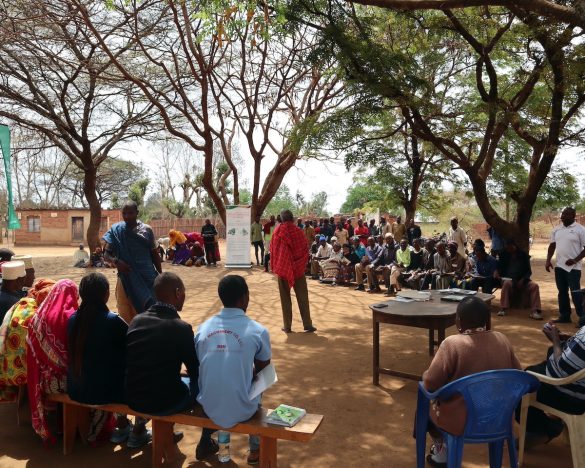Africa RISING field days showcase enhancements in crop and forage yields in the Ethiopian highlands
In the last quarter of each year, an Africa RISING project being conducted in the highlands of Ethiopia, holds series of field days there. This project is conducting research-for-development activities to narrow gaps in farmer yields of crops and livestock feeds. These field days, which included ‘experience sharing programs’, were held in four of Ethiopia’s nine regional states—Amhara, Tigray, Oromia and the Southern Nations, Nationalities and Peoples’ Region (SNNPR)—in Nov and Dec 2019.
Senior officials from the four regions, ministry of agriculture, research centers, Universities, development agencies, nongovernmental organizations, media and zonal and district administrations as well as local farmers participated in the field days, which showcased African RISING activities to improve crop performance, seed multiplication, and use of livestock feed and forage technologies in Endamhoni, Basona, Sinana and Lemo sites.
The field days helped promote information exchange and technology transfer among farmers and other stakeholders in agricultural development in these regions. The farmers participating in the field days benefited from being linked up with local food and feed processors. Farmers in Endamehoni benefited from an advanced seed multiplication system for improved wheat, faba bean and barley varieties; good practices in participatory varietal selection; technologies for better integration of crop growing and livestock raising; and livestock feed trials.
Mohammed Ebrahim, the Endamhoni site coordinator for this project, briefly explained to all those participating in his field day the various trials being conducted and the specific crop and forage varieties being tested; he covered best practices in land preparation, planting, seed and fertilizer applications and weeding.
The field day at Basona, in the Amhara region, showcased a wider variety of activities and technologies, including large-scale seed multiplication of wheat and barley. The participants visited farm households employing, and benefiting from, improved livestock feed troughs and technologies, which are yielding better managed animals for live sales and dairy products. And they had an opportunity to visit the local Angolela Milk Cooperative Union.
‘In the past, I used local seeds from my own crops or bought them from a neighbor’, said Mr. Getaneh Temtem a farmer in Basona. ‘The yield from those local varieties were unsatisfactory. Now I use “wonye” wheat improved variety that I obtained from the Africa RISING project and the yield and biomass is very impressive.’
Improved varieties of avocado and better methods for producing ‘enset’ (false banana) were showcased in the field day at the Lemo site in SNNPR. At this site, the Africa RISING project had introduced water ponds and solar pumps. Use of these irrigation technologies led not only to increased smallholder incomes but also to use of improved crop varieties. Farmers who produce wheat in cluster [cluster approach is an initiative that contains geographically specialized priority commodities across the four major agricultural regions of the country). These clusters are intended to act as Centers of Excellence where regions will be supported to maximize production and productivity] and produce varieties of seed for multiplication shared their experiences with other farmers. The cluster approach helps to produce quality seeds, enhance collective action and facilitate use of mechanization.
This series of end-of-year Africa RISING field days ended at the Sinana site, which is known for its high wheat production. Participants were shown on-farm adaptation trials of forage crops, wheat seed multiplication and soil fertility trials.
At the close of the field days, Kindu Mekonnen, coordinator of the Africa RISING project in the Ethiopian highlands, called on the farmers to continue their adoption of these new and research-validated technologies and on government and other officials to scale up their use so as to benefit more farmers in wider areas.
Click here to watch videos produced by local media houses of the field day activities in each of the regions.







